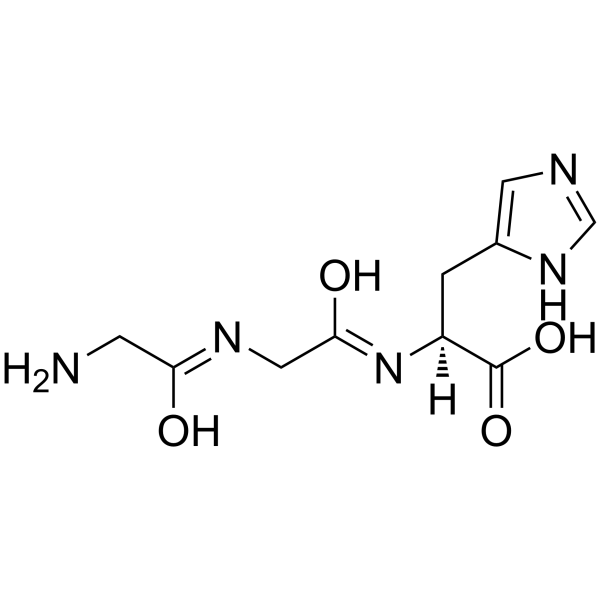Generation of free radicals from lipid hydroperoxides by Ni2+ in the presence of oligopeptides.
X Shi, N S Dalal, K S Kasprzak
文献索引:Arch. Biochem. Biophys. 299(1) , 154-62, (1992)
全文:HTML全文
摘要
The generation of free radicals from lipid hydroperoxides by Ni2+ in the presence of several oligopeptides was investigated by electron spin resonance (ESR) utilizing 5,5-dimethyl-1-pyrroline N-oxide (DMPO) as a spin trap. Incubation of Ni2+ with cumene hydroperoxide or t-butyl hydroperoxide did not generate any detectable free radical. In the presence of glycylglycylhistidine (GlyGlyHis), however, Ni2+ generated cumene peroxyl (ROO.) radical from cumene hydroperoxide, with the free radical generation reaching its saturation level within about 3 min. The reaction was first order with respect to both cumene hydroperoxide and Ni2+. Similar results were obtained using t-butyl hydroperoxide, but the yield of t-butyl peroxyl radical generation was about 7-fold lower. Other histidine-containing oligopeptides such as beta-alanyl-L-histidine (carnosine), gamma-aminobutyryl-L-histidine (homocarnosine), and beta-alanyl-3-methyl-L-histidine (anserine) caused the generation of both cumene alkyl (R.) and cumene alkoxyl (RO.) radicals in the reaction of Ni2+ with cumene hydroperoxide. Similar results were obtained using t-butyl hydroperoxide. Glutathione also caused generation of R. and RO. radicals in the reaction of Ni2+ with cumene hydroperoxide but the yield was approximately 25-fold greater than that produced by the histidine-containing peptides, except GlyGlyHis. The ratio of DMPO/R. and DMPO/RO. produced with glutathione and cumene hydroperoxide was approximately 3:1. Essentially the same results were obtained using t-butyl hydroperoxide except that the ratio of DMPO/R. to DMPO/RO. was approximately 1:1. The free radical generation from cumene hydroperoxide reached its saturation level almost instantaneously while in the case of t-butyl hydroperoxide, the saturation level was reached in about 3 min. In the presence of oxidized glutathione, the Ni2+/cumene hydroperoxide system caused DMPO/.OH generation from DMPO without forming free hydroxyl radical. Since glutathione, carnosine, homocarnosine, and anserine are considered to be cellular antioxidants, the present work suggests that instead of protecting against oxidative damage, these oligopeptides may facilitate the Ni(2+)-mediated free radical generation and thus may participate in the mechanism(s) of Ni2+ toxicity and carcinogenicity.
相关化合物
| 结构式 | 名称/CAS号 | 分子式 | 全部文献 |
|---|---|---|---|
 |
甘氨酰甘氨酰-L-组氨酸
CAS:7451-76-5 |
C10H15N5O4 |
|
Copper.Lys-Gly-His-Lys mediated cleavage of tRNA(Phe): studi...
2009-06-01 [J. Inorg. Biochem. 103 , 871-875, (2009)] |
|
Effect of Gly-Gly-His, Gly-His-Lys and their copper complexe...
2012-01-01 [Acta Pol. Pharm. 69(6) , 1303-6, (2012)] |
|
Highly specific oxidative cross-linking of proteins mediated...
1995-04-11 [Biochemistry 34(14) , 4733-9, (1995)] |
|
Diastereoselective DNA cleavage recognition by Ni(II) x Gly-...
2006-03-15 [J. Am. Chem. Soc. 128(10) , 3198-207, (2006)] |
|
Protein cross-linking mediated by metal ion complexes.
2001-01-01 [Met. Ions Biol. Syst. 38 , 351-84, (2001)] |